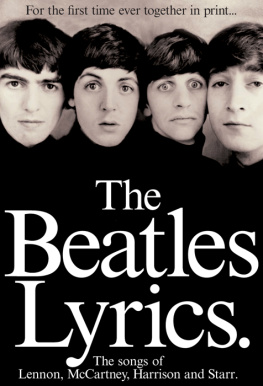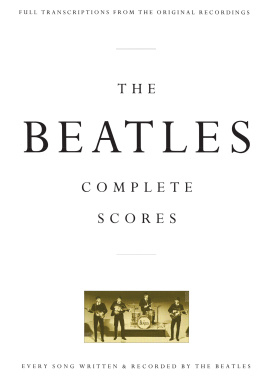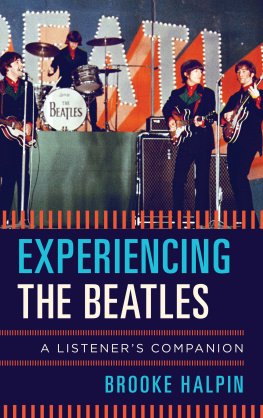
THIS IS A CARLTON BOOK
First published by Carlton Books Limited 1994
This edition published by
Carlton Books Limited 2009
Text copyright Steve Turner 1994, 1999, 2005, 2009
Design copyright Carlton Books Limited 1994, 1999, 2005, 2009
All rights reserved.
This book is sold subject to the condition that it shall not, by way of trade or otherwise, be lent, resold, hired out or otherwise circulated without the publishers prior written consent in any form of cover or binding other than that in which it is published and without a similar condition including this condition being imposed upon the subsequent purchaser.
eISBN 978-1-78011-188-9
PREFACE
This book tells the stories behind the Beatles songs, which Ive defined as songs written and recorded by the Beatles. It looks at the how, why and where of the songwriting and traces the inspiration back to source.
Having said that, this is not a book about how the Beatles recorded the songs, nor about who played what on which sessions. Mark Lewisohn has done that job definitively in The Complete Beatles Recording Sessions. Neither is it a book of in-depth musical analysis. For this approach, see Twilight Of The Gods by Professor Wilfrid Mellers (Schirmer Books, 1973) or The Songwriting Secrets Of The Beatles by Dominic Pedler (Omnibus Press, 2003).
Also exemplary is Revolution in the Head by Ian MacDonald (Fourth Estate, 1994). MacDonald takes the same song-by-song approach that this book takes and his insights and depth of knowledge about popular music of the sixties are unparalleled.
This is also not a book that explains what the Beatles were really trying to say. Although Ive given outlines of many songs and have referred to psychological factors that I believe influenced the standpoint of the writing, Ive left the task of interpretation to others. If you do want to know what Paul was saying, read a book like Paul McCartney: From Liverpool To Let It Be by Howard DeWitt (Horizon Books, 1992) or, if you want to catch the drift of Johns intellectual development, read The Art and Music of John Lennon by John Robertson (Omnibus, 1990) or John Lennons Secret by David Stuart Ryan (Kozmik Press, 1982).
What I have tried to do is simply to tell the story of how each song came into being. It could have been a musical inspiration, such as trying to write in the style of Smokey Robinson. It could have been a phrase that just wouldnt go away, like the waves of sorrow, pools of joy line that compelled John to write Across The Universe. Or it could have been an incident like the death of socialite Tara Browne which led to the writing of a section of A Day In The Life.
My primary source has been the words of the Beatles themselves. I was fortunate enough to meet John, interviewing him and Yoko at the Apple office in Savile Row in the summer of 1971, shortly before Imagine was released. I remember complimenting him on the personal nature of his new songs that had come after an intense period of therapy. My songs have always been personal, he responded. Help! was personal. Youve Got To Hide Your Love Away was personal. Im A Loser was personal. Ive always been on that kick.
I didnt meet Paul until 1992 when I was asked to help Linda in the writing of the text for her photographic book Linda McCartneys Sixties: Portrait Of An Era. I had hoped that Paul would contribute his own memories but he decided that he couldnt just dip into a project like this and yet didnt have the time to make a full commitment. He did, however, point out some discrepancies in the stories I had collected so far which I was then able to change.
The most reliable comments on the songs being those made by the Beatles themselves, Ive drawn extensively on the published interviews I have personally collected since beginning my first Beatles scrapbook in 1963. Those that I had missed, I searched out at the National Newspaper Library and the National Sound Archives in London. There were seven invaluable written accounts which I found myself coming back to repeatedly and without which I wouldnt have known where to start. In order of publication these were: Alan Aldridges interview with Paul McCartney published as A Good Gurus Guide To The Beatles Sinister Songbook in the Observer magazine, London, on November 26, 1967; The Beatles by Hunter Davies, 1968; Lennon: The Greatest Natural Songwriter of our Time by Mike Hennessey in Record Mirror, October 2, 1971 (reprinted in Hit Parade, April 1972); Lennon Remembers by Jann Wenner, 1971; I Me Mine by George Harrison, 1980, The Playboy Interviews with John Lennon and Yoko Ono, 1981 and Paul McCartney: Many Years From Now by Barry Miles (1997). There were also two radio series which shed light on the songwriting: Mike Reads McCartney On McCartney, broadcast on BBC Radio 1 during 1989, and The Lost Lennon Tapes, an American production featuring demo tapes from Johns private collection which Yoko had allowed to be broadcast for the first time.
As informative as all these were, they didnt tell me the whole story. Many of the anecdotes are already well known. I wanted to interview the people who were around when the songs were written, or who had even been the subject of songs. I also wanted to track down the newspaper stories which had provided ideas, the books from which theyd taken lines and the places which had inspired them. I wanted to surprise even the remaining Beatles themselves because I knew that they didnt know who Mr Kite really was or what happened to the girl whose story inspired Shes Leaving Home.
The definitive book on this subject wont be written until Johns and Georges journals, letters and work books are made public and Paul and Ringo sit down in front of a microphone and share everything they remember about the 208 songs which the Beatles recorded. The chances are, though, that Johns material will remain locked in vaults for the foreseeable future because much of it refers to people still living and Yoko believes that it is too sensitive to release. The six-part television series The Beatles Anthology and the accompanying biography of the Beatles was disappointing to anyone expecting the remaining members of the Beatles to tell hitherto-untold stories.
Thats why it was worth compiling this book. It may be the closest well ever get to understanding how the Beatles conjured up their songwriting magic.
Steve Turner
London, November 1998 and March 2005
This book is dedicated to the memory of T-Bone Burnett and Larry Norman in memory of many hours of Beatle-talk over the years.
CONTENTS
Penny Lane; Strawberry Fields Forever; Sgt Peppers Lonely Hearts Club Band; With A Little Help From My Friends; Lucy In The Sky With Diamonds; Getting Better; Fixing A Hole; Shes Leaving Home; Being For The Benefit of Mr Kite!; Within You Without You; When Im Sixty-Four; Lovely Rita; Good Morning, Good Morning; A Day In The Life
All You Need Is Love; Baby, Youre A Rich Man; Hello Goodbye; Only A Northern Song; All Together Now; Hey Bulldog; Its All Too Much; Magical Mystery Tour; The Fool On The Hill; Flying; Blue Jay Way; Your Mother Should Know; I Am the Walrus; Lady Madonna; The Inner Light; Hey Jude
Back In The USSR; Dear Prudence; Glass Onion; Ob-La-Di Ob-La-Da; Wild Honey Pie; The Continuing Story of Bungalow Bill; While My Guitar Gently Weeps; Happiness Is A Warm Gun; Martha My Dear; Im So Tired; Blackbird; Piggies; Rocky Raccoon; Dont Pass Me By; Why Dont We Do It In The Road?; I Will; Julia; Birthday; Yer Blues; Mother Natures Son; Everybodys Got Something To Hide Except Me And My Monkey; Sexy Sadie; Helter Skelter; Long Long Long; Revolution; Honey Pie; Savoy Truffle; Cry Baby Cry; Revolution 9; Good Night; Dont Let Me Down
Next page


















